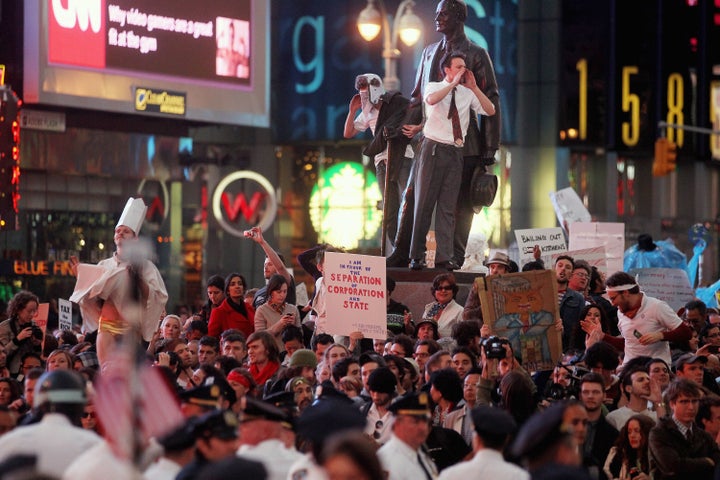
The prophets are among us. The recent upsurge in radical activism -- by immigrants in Arizona, public sector workers in Wisconsin, marriage equality activists and Wall Street occupiers -- revives the spirit of the Hebrew prophets and of the abolitionists, feminists, socialists and pacifists of American history. My new book, "Prophetic Encounters: Religion and the American Radical Tradition," demonstrates that radicalism cannot be fully understood apart from the religious ideas and institutions that have inspired and sustained it.
Radical activism is "prophetic," I believe, because it mirrors the religious phenomena of revelation and conversion. The ancient prophets Amos and Jeremiah continue to inspire activists to "speak truth to power," whether or not they share the theologies of Amos and Jeremiah. When people share their stories of marginalization, struggle and hope for a better world, they gain new purpose and new identity. America's earliest labor activists did it by naming themselves "Working Men" and electing other workers to political office. The first black abolitionists took pride in their "African" identity but also insisted that they had a full place at the table of American power. Empowered by new identities, activists worked to "build a new society within the shell of the old," to use a slogan from the Industrial Workers of the World, or to create the "beloved community," to use a phrase Martin Luther King Jr., borrowed from the philosopher Josiah Royce. Most radical movements have had their own hymns, from "John Brown's Body" to "Solidarity Forever;" they offer pilgrimage in the form of protest marches and sacramental initiation through civil disobedience. Mainstream politics, with its horse-trading and pragmatic compromises, may not look much like a religion. But radicalism burns with divine fire.
The similarities between radical activism and religion help explain why religious institutions and ideas have made vital contributions to every movement for social change in the United States. The Working Men often gathered at Universalist churches or congregations of "Free Thinkers." Abolitionism had deep roots in Black Methodist and Baptist congregations, as well as lodges of Black Freemasons. 19th century women's rights speakers were often Quaker leaders or ordained Protestant ministers or Spiritualist mediums. The activists who marched arm-in-arm at Selma in 1965 were not only black and white, but also Catholic and Protestant, Jewish and Unitarian Universalist. And the Occupy Boston encampment is home to a "spirituality tent," a Jewish sukkah or tabernacle and a cadre of "Protest Chaplains," many of them Divinity students, who help their comrades find the spirituality in their activism.
My conversations with these students have reinforced my sense that radicalism can never transcend its spiritual roots. "At Occupy Boston I feel a sense of purpose I've never experienced before," one student declared. "My friend has never seemed so happy," observed another. Such comments contrast sharply with the mood at commencement time, when extraordinarily talented and well-prepared graduates step timidly out into a world with few jobs and little hope. They suggest that participants in the "Occupy" movement are empowering themselves as well as working to change society. Like countless activists in past generations, they experience "prophetic encounters" when they work together for change.
But the similarities between religion and radicalism also explain the recurring tensions between the "religious" and the "secular" left. In every generation, some activists--abolitionist John Brown, for example, and Catholic Worker Dorothy Day--have seen their work for justice as confirmation of the transcendent visions of Jesus, Moses, Buddha or Muhammad. Their participation in conventional religious communities has deepened their activism, and vice versa. But other activists have felt betrayed by the timidity of conventional religion. For them, the movement is the true church, far superior to "pie in the sky" religion. The white abolitionist movement split in 1840 between those who wanted to work within existing churches, those who wanted to create new, anti-slavery churches and those who wanted to "come out" of all organized religion. Similar divisions threatened women's rights and socialism, and they are present at Occupy Boston as well: one prayer service conducted in the spirituality tent was interrupted by another activist who implied they'd be siding with the police if they didn't immediately join in civil disobedience.
Such conflicts are as inevitable as they are painful. The Hebrew prophet Isaiah compared God's call to having a burning coal placed on his lips and the encounters of activism can be just as fiery. Activist spirituality changes constantly, in unpredictable directions, because activists are also encountering the sacred afresh in one another. It happens when Metropolitan Community Church congregations, Wiccan covens and gatherings of Radical Faeries find the divine through shared celebration of sexuality. It happens when Unitarian Universalists don yellow shirts that read "Standing on the Side of Love" and apprentice themselves to immigrant communities in Arizona. It happens when urban youngsters stick their hands into the rich compost of an organic farm. Wherever humans encounter one another deeply, they find a power that might be named spirit or mana, God or Goddess. For two centuries, this power has placed Americans on the path toward justice -- and it is still available to us today.